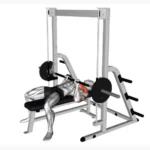Standing Dumbbell Front Raise Overview
The standing dumbbell front raise is an effective isolation exercise that targets the anterior (front) deltoids, with secondary engagement of the upper chest and trapezius muscles. This movement strengthens the shoulders, enhancing performance in pressing exercises like bench presses or overhead presses. It’s a versatile addition to shoulder workouts, upper-body routines, or full-body strength programs, suitable for beginners and advanced lifters.
The dumbbell variation allows for a natural range of motion and unilateral control, helping to address muscle imbalances. From an aesthetic perspective, stronger front deltoids create a broader, more defined shoulder profile, contributing to a balanced upper-body appearance. Incorporate standing dumbbell front raises to build shoulder strength, improve posture, and boost functional fitness for activities like lifting or reaching overhead.
Standing Dumbbell Front Raise Instructions
- Select Dumbbells: Choose a pair of dumbbells with a weight that challenges you but allows controlled movement. Beginners should start light (e.g., 5-10 lbs) to focus on proper form.
- Position Your Body: Stand with feet shoulder-width apart for stability, knees slightly bent to reduce lower-back strain. Engage your core, keep your chest lifted, and maintain a neutral spine with shoulders retracted.
- Grip the Dumbbells: Hold a dumbbell in each hand with a pronated grip (palms facing down), arms extended in front of your thighs. Maintain a slight bend in your elbows to avoid joint stress.
- Initiate the Raise: Brace your core and slowly lift the dumbbells forward and upward, keeping your arms nearly straight with a slight elbow bend. Move only your shoulders to isolate the front deltoids.
- Reach Peak Height: Raise the dumbbells until your arms are parallel to the ground (shoulder height), pausing briefly to engage the front deltoids fully. Avoid lifting higher to prevent impingement.
- Lower the Dumbbells: Slowly lower the dumbbells back to the starting position in a controlled manner, maintaining tension in your shoulders and avoiding swinging.
- Repeat: Perform 3 sets of 10-12 reps, resting 60-90 seconds between sets. Focus on smooth, deliberate movements for optimal muscle activation.
Standing Dumbbell Front Raise Tips
- Prioritize Form: Use lighter weights to master technique before increasing resistance to avoid strain or injury.
- Avoid Momentum: Keep your torso stationary and avoid leaning back or swinging the dumbbells to ensure the front deltoids do the work.
- Controlled Tempo: Use a slow, steady motion (e.g., 2 seconds up, 2 seconds down) to maximize time under tension and enhance muscle growth.
- Breathing Technique: Inhale as you prepare to lift and exhale as you raise the dumbbells, inhaling again as you lower them to maintain rhythm and core stability.
- Elbow Position: Maintain a slight bend in your elbows throughout to protect joints and focus effort on the shoulders.
- Shoulder Alignment: Avoid shrugging your shoulders toward your ears to prevent trapezius overuse. Keep shoulders relaxed and retracted.
- Variation Options: Try alternating arms or using a barbell for variety, or perform seated front raises to reduce body sway.
- Progress Gradually: Increase weight or reps as strength improves, but prioritize form to maximize results and minimize risk.
Benefits: The standing dumbbell front raise builds stronger, more defined front deltoids, improves shoulder stability, and enhances performance in pressing movements. It also contributes to a broader upper-body aesthetic and supports functional tasks like overhead lifting.
Targeting front delts with raises? Dive into our Ultimate Guide to Muscle Groups for shoulder development.






